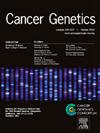PIK3CA畸变在癌症类型中的患病率和临床意义:一种真实世界的下一代测序方法
IF 2.1
4区 医学
Q4 GENETICS & HEREDITY
引用次数: 0
摘要
磷脂酰肌醇3-激酶(PI3K)途径的激活是各种实体肿瘤中常见的致癌机制,通常由PIK3CA基因畸变驱动。最近的进展表明pik3ca突变乳腺癌患者的有效治疗;然而,对其他恶性肿瘤的需求尚未得到满足。这项研究的目的是为了更好地了解PIK3CA突变和不同癌症类型的扩增。方法2019年10月至2023年6月,利用Trusight Oncology 500对三星首尔医院36种不同癌症类型的3886例患者进行了新一代测序。本文综述了PIK3CA突变和扩增的发生率及其与肿瘤突变负荷(TMB)、微卫星不稳定性(MSI)和同源重组缺陷(HRD)状态的相关性。突变位点也被确定。结果3886例患者中,PIK3CA突变发生率为9.2%(358/3886),其中结直肠癌发生率最高,为52.8%(189/358)。携带PIK3CA突变的患者TMB和MSI-high的发生率明显高于未携带PIK3CA突变的患者(分别为31.8% vs 12.5% TMB和7.8% vs 1.6% MSI-high, p = 0.001)。相比之下,在1.3%(51/3886)的患者中观察到PIK3CA扩增,主要是在胃癌,膀胱癌和结直肠癌中,并且与较低的TMB, MSI-high和HRD发生率相关。在3例患者中发现了PIK3CA融合。最常见的突变位点为E545K、E542K和H1047R。结论3886例转移性实体瘤患者中,358例(9.2%)存在PIK3CA突变,51例(1.3%)存在PIK3CA扩增。下一代测序分析提供了对PIK3CA畸变更深入的了解。本文章由计算机程序翻译,如有差异,请以英文原文为准。
Prevalence and clinical implications of PIK3CA aberrations across cancer types: A real-world next-generation sequencing approach
Background
Activation of the phosphatidylinositol 3-kinase (PI3K) pathway is a common oncogenic mechanism in various solid tumors and is often driven by aberrations in the PIK3CA gene. Recent advancements have shown effective treatment for patients with PIK3CA-mutated breast cancer; however, there is an unmet need for other malignancies. The aim of this study was to gain a better understanding of PIK3CA mutations and amplifications across cancer types.
Methods
From October 2019 to June 2023, we performed next-generation sequencing using Trusight Oncology 500 on 3886 patients with 36 different cancer types at the Samsung Medical Center. The incidence of PIK3CA mutations and amplifications according to cancer type and their correlation with the tumor mutation burden (TMB), microsatellite instability (MSI), and homologous recombination deficiency (HRD) status were reviewed. Mutation sites were also identified.
Results
Among the 3886 patients, PIK3CA mutations were present in 9.2 % (358/3886) of the cohort, with colorectal cancer, 52.8 % (189/358), having the highest incidence. Patients harboring PIK3CA mutations demonstrated significantly higher TMB and MSI-high rates than those without (31.8 % vs. 12.5 % for TMB and 7.8 % vs. 1.6 % for MSI-high, respectively, p = 0.001). In contrast, PIK3CA amplifications were observed in 1.3 % (51/3886) of patients, primarily in gastric, bladder, and colorectal cancers, and associated with lower TMB, MSI-high, and HRD rates. PIK3CA fusions were identified in three patients. The most common mutation sites were E545K, E542K, and H1047R.
Conclusion
Of 3886 patients with metastatic solid tumors, 358(9.2 %) had PIK3CA mutations and 51(1.3 %) had PIK3CA amplifications. Next-generation sequencing analysis provided a deeper understanding of PIK3CA aberrations.
求助全文
通过发布文献求助,成功后即可免费获取论文全文。
去求助
来源期刊

Cancer Genetics
ONCOLOGY-GENETICS & HEREDITY
CiteScore
3.20
自引率
5.30%
发文量
167
审稿时长
27 days
期刊介绍:
The aim of Cancer Genetics is to publish high quality scientific papers on the cellular, genetic and molecular aspects of cancer, including cancer predisposition and clinical diagnostic applications. Specific areas of interest include descriptions of new chromosomal, molecular or epigenetic alterations in benign and malignant diseases; novel laboratory approaches for identification and characterization of chromosomal rearrangements or genomic alterations in cancer cells; correlation of genetic changes with pathology and clinical presentation; and the molecular genetics of cancer predisposition. To reach a basic science and clinical multidisciplinary audience, we welcome original full-length articles, reviews, meeting summaries, brief reports, and letters to the editor.
 求助内容:
求助内容: 应助结果提醒方式:
应助结果提醒方式:


